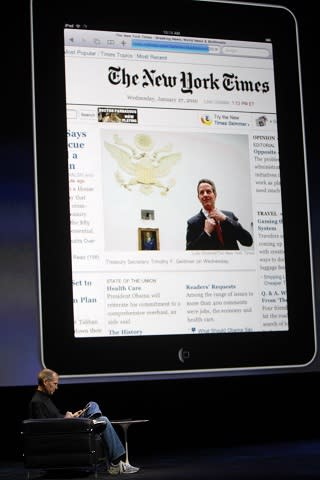 The Upshot
The UpshotAmericans spending more time consuming news, study finds

Fewer Americans may be buying daily newspapers or watching a network newscast, but that doesn't mean interest in the news is dropping.
In fact, a new Pew study finds that Americans are spending an average of 57 minutes each day consuming news from traditional media outlets like TV, radio or newspapers — the same amount as a decade ago. What's changed is that Americans now spend an additional 13 minutes consuming news online, bringing the daily total up to 70 minutes.
The biennial study from Pew's Research Center for People & the Press notes that is "one of the highest totals on this measure since the mid-1990s and it does not take into account time spent getting news on cell phones or other digital devices." So it can be expected that the total would exceed 70 minutes when factoring all the other ways people consume news today.
Increasingly, news consumers look for up-to-the-minute information online. But the study finds that "instead of replacing traditional news platforms, Americans are increasingly integrating new technologies into their news consumption habits."
For instance, newspapers remain a vital source of news even as print consumption drops. Now, just over a quarter of Americans still read a print newspaper — down from 30 percent in 2008 and 38 percent in 2006. Still, younger readers — who may have never dropped change into a newspaper box — continue flocking to websites like NYTimes.com. Indeed, the Times boasts the youngest newspaper audience online, with more than a third of its readers under 30.
Times executives will probably consider such statistics as the paper prepares to launch a metered pay model that could erode online readership. In addition, the study notes that nearly "one-in-ten of internet users younger than 30 (8%) — and 6% of all internet users — volunteer the New York Times when asked to name a few of the websites they use most often to get news and information."
The study also looks beyond consumption across platforms and into how ideological viewpoints shape where people look for news. Political views appear to have the greatest effect when it comes to frequently partisan cable news, a platform where 39 percent of Americans regularly get news.
Fox News — with conservative commentators like Bill O'Reilly, Sean Hannity and Glenn Beck — unsurprisingly brings in more Republican viewers. But this latest study shows just how much that number has increased over the years.
These days, about 40 percent of Republicans regularly watch Fox News — a figure that's 22 points higher than it was a decade ago. In 2002, Republicans were still tuning into CNN (28 percent) more than Fox News (25 percent). Now, just 12 percent of Republicans regularly watch CNN, with only 6 percent flipping over to MSNBC.
Although claims of media bias typically come from the right, Pew now finds that liberals are also enjoying consuming the news from mainstream sources less than they had in the past:
"The decline is linked to partisanship and ideology: in 2008 67% of liberal Democrats said they enjoyed the news a lot, compared with just 45% today. By contrast, about as many conservative Republicans say they enjoy keeping up with the news today as did so two years ago (57% now, 56% then). This has resulted in a switch in news enjoyment. Today, conservative Republicans enjoy keeping up with the news more than any other ideological and partisan group; just two years ago it was the liberal Democrats who held that distinction."
Pew also notes where President Obama has the most fans. No, it's not on Hannity's prime-time Fox News show, where just 7 percent of his audience views the president favorably. Obama gets his highest approval ratings among Keith Olbermann (84 percent) and Rachel Maddow (80 percent) viewers on MSNBC, along with regular readers of the New York Times (79 percent).
(Photo of Apple chief Steve Jobs demonstrating the New York Times on Apple's iPad: AP/ Marcio Jose Sanchez)

